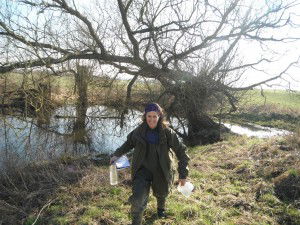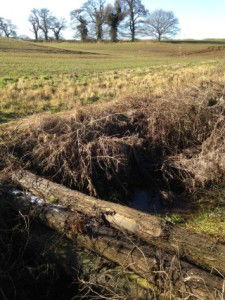What next for Water Friendly Farming?
31st March 2016
Water Friendly Farming is our largest current research project and we are now beginning the next important phase of this project.
Water Friendly Farming’s aim is to provide us with the information we need about what works best when it comes to protecting freshwaters from the unwanted damaging impacts of commercial farming. Specifically, we are trying to find out whether we can reduce the impact on freshwater biodiversity across the whole landscape, reduce water pollution and hold back water in an effort to reduce downstream flooding.
To do this we are running a large experiment to assess the combined effect of the wide range of mitigation methods used to try to reduce the impact of farming on freshwaters. Methods include reducing the amount of ploughing and adding buffer strips to stop soil and fertilisers washing off the land, damming ditches to intercept polluted water and trap sediment, and adding new freshwater habitat to the landscape, particularly ponds, to provide better quality habitat for freshwater wildlife.
 Work of this sort is inevitably long-term: although we are now 5 years into the project, much of that time has been spent establishing the baseline conditions. If you want to understand whether making changes to the landscape is having any effect it’s important to know how things were before you started, and it’s also important to have an area to compare with where you change nothing, which statisticians call the control. All of this makes work like Water Friendly Farming expensive: one of the biggest challenges of this kind of work is finding the large sums of money for the work.
Work of this sort is inevitably long-term: although we are now 5 years into the project, much of that time has been spent establishing the baseline conditions. If you want to understand whether making changes to the landscape is having any effect it’s important to know how things were before you started, and it’s also important to have an area to compare with where you change nothing, which statisticians call the control. All of this makes work like Water Friendly Farming expensive: one of the biggest challenges of this kind of work is finding the large sums of money for the work.
Our baseline work has provided important information, and has given us the foundations for some interesting early results. These results are described in the report we produced at the end of 2014.
 Now we are beginning the next phase of the work, with a special emphasis on how much we can do to hold back water in the landscape. The winter floods of 2015 have given a huge new impetus to the idea of natural flood management – managing the land to hold back water – and we have been in the thick of the debate. Although it seems obvious that planting trees, making streams more bendy and building ponds to hold water will all help to reduce floods by reducing runoff, in reality nobody knows for sure how large the effect will be. Certainly, if you push water onto the floodplain and hold it back with specially constructed bunds, as has been well-demonstrated, you can make a difference. But the crucial next step is to link work like this directly to the computer models of flooding that the Environment Agency uses to design flood defense schemes. And this is what we will be doing in Water Friendly Farming over the next few years: creating a network of leaky dams on streams, and other ways of storing and holding back water, and testing them with computer models directly linked to the Environment Agency’s flood models. This will give us, for the first time, a precise understanding of how natural land management methods compare and contribute to the traditional flood defence methods using ‘hard engineering’.
Now we are beginning the next phase of the work, with a special emphasis on how much we can do to hold back water in the landscape. The winter floods of 2015 have given a huge new impetus to the idea of natural flood management – managing the land to hold back water – and we have been in the thick of the debate. Although it seems obvious that planting trees, making streams more bendy and building ponds to hold water will all help to reduce floods by reducing runoff, in reality nobody knows for sure how large the effect will be. Certainly, if you push water onto the floodplain and hold it back with specially constructed bunds, as has been well-demonstrated, you can make a difference. But the crucial next step is to link work like this directly to the computer models of flooding that the Environment Agency uses to design flood defense schemes. And this is what we will be doing in Water Friendly Farming over the next few years: creating a network of leaky dams on streams, and other ways of storing and holding back water, and testing them with computer models directly linked to the Environment Agency’s flood models. This will give us, for the first time, a precise understanding of how natural land management methods compare and contribute to the traditional flood defence methods using ‘hard engineering’.
Water Friendly Farming is a good example of our partnership approach and is run jointly with the Game & Wildlife Conservation Trust and a range of other partners, including the University of York and University of Sheffield, Oxford Brookes University, the Environment Agency (who are the biggest funders of the work) and Syngenta.
Find out more about Water Friendly Farming and natural flood defences:
- Visit the Water Friendly Farming webpage and read the report of initial results (PDF).
- Read about the myths and reality of floods and land management.
- See the presentation on natural flood defences Dr Jeremy Biggs gave to the All Party Parliamentary Group on Biodversity in Westminster.

